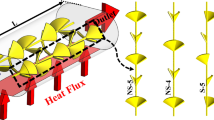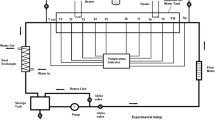Abstract
Heat transfer and turbulent flow of Al2O3-water nanofluid within alternating oval cross-section tube are numerically simulated using Eulerian-Eulerian two-phase mixture model. The primary goal of the present study is to investigate the effects of nanoparticles volume fraction, nanoparticles diameter and different inlet velocities on heat transfer, pressure drop and entropy generation characteristics of the alternating oval cross-section tube. For numerical simulation validation, the numerical results were compared with experimental data. Also, constant wall temperature boundary condition was considered on the tube wall. In addition, the comparison of thermal-hydraulic performance and the entropy generation characteristics between alternating oval cross-section tube and circular tube under same fluids were done. The results show that the heat transfer coefficient and pressure drop of alternating oval cross-section tube is more than base tube under same fluids. Also, these two parameters are increased when adding Al2O3 nanoparticle into water fluid, at any inlet velocity for both tubes. Furthermore, compared to the base fluid, the value of the heat transfer enhancement of nanofluid is higher than the increase of friction factor of nanofluid at the same given inlet boundary conditions. The results of entropy generation analysis illustrate that the total entropy generation increase with increasing the nanoparticles volume fraction and decreasing the nanoparticles diameter of nanofluid. The generation of thermal entropy is the main part of irreversibility, and Bejan number with an increase of the nanoparticles diameter slightly increases. Finally, at any given inlet velocity the frictional irreversibility is grown with an increase the nanoparticles volume fraction.















Similar content being viewed by others
Abbreviations
- A :
-
Area, m2.
- Be :
-
Bejan number.
- C p :
-
Specific heat, J/(kg K).
- D h :
-
Hydraulic diameter, m.
- d p :
-
Diameter of the nanoparticle, m.
- d f :
-
Equivalent diameter of a base fluid molecule, m.
- f :
-
Friction factor, \( f=\left(\mathit{\Delta p}\ {D}_h\right)/\left(\frac{1}{2}\rho {u}_{avg}^2\ L\right). \)
- f drag :
-
Drag function
- g :
-
Gravitational acceleration, m/s2
- h :
-
Heat transfer coefficient, W/(m2 K)
- K :
-
Thermal conductivity, W/(m K)
- K b :
-
Boltzmann’s constant, 1.38066 × 10−23 J/K
- k :
-
Turbulent kinetic energy, m2/s2
- L :
-
Total length of tube, mm
- M :
-
Molecular weight of the base fluid, kg/mol
- N :
-
Avogadro number, 6.022 × 1023 mol−1
- Nu :
-
Nusselt number, Nu = (q”Dh)/(K (Tw − Tb))
- P :
-
Pressure, kg/(m s2)
- G k :
-
Production of turbulent kinetic energy, kg/(m s3)
- Pr :
-
Prandtl number, Pr = μCp/K
- q” :
-
Heat flux, W/m2
- Re :
-
Reynolds number, Re = ρuDh/μ
- \( {S}_{gen}^{"\hbox{'}} \) :
-
Entropy generation, W/m3 K
- S gen :
-
Entropy generation, W/K
- T :
-
Temperature, K
- u i :
-
Velocity, m/s
- V m :
-
Mass average velocity, m/s
- y + :
-
Dimensionless wall distance, \( {y}^{+}=\left(\sqrt{\tau_w/\rho }\ Y\right)/\upsilon \)
- Y :
-
Distance of the closest computational node from the wall, m
- z :
-
Axial distance from inlet, m
- φ :
-
Volume fraction of nanoparticle
- ε :
-
Turbulent dissipation rate, m2/s3
- ϑ Br :
-
Brownian velocity of the nanoparticle, m/s
- μ :
-
Laminar dynamic viscosity, kg/(m s)
- μ t :
-
Turbulent dynamic viscosity, kg/(m s)
- ρ :
-
Density, kg/m3
- ρ f0 :
-
Mass density of the base fluid at 293 K, kg/m3
- σ k :
-
Turbulent Prandtl number of k
- τ :
-
Shear stresse, N/m2
- σ ε :
-
Turbulent Prandtl number of ε
- avg. :
-
Average
- b :
-
Bulk
- bf :
-
Base fluid
- f :
-
Frictional
- m :
-
Mixture
- nf :
-
Nanofluid
- p :
-
Nanoparticle
- T :
-
Total
- th :
-
Thermal
- w :
-
Wall
References
Mohammadian SK, Seyf HR, Zhang Y (2014) Performance augmentation and optimization of aluminum oxide-water nanofluid flow in a two-fluid microchannel heat exchanger. J Heat Transf 136(2):021701
Fule PJ, Bhanvase BA, Sonawane SH (2017) Experimental investigation of heat transfer enhancement in helical coil heat exchangers using water based CuO nanofluid. Adv Powder Technol 28(9):2288–2294
Meng J-A, Liang X-G, Chen Z-J, Li Z-X (2005) Experimental study on convective heat transfer in alternating elliptical axis tubes. Exp Thermal Fluid Sci 29(4):457–465
Sajadi AR, Yamani Douzi Sorkhabi S, Ashtiani D, Kowsari F (2014) Experimental and numerical study on heat transfer and flow resistance of oil flow in alternating elliptical axis tubes. Int J Heat Mass Transf 77:124–130
Zheng N, Liu P, Shan F, Liu Z, Liu W (2016) Heat transfer enhancement in a novel internally grooved tube by generating longitudinal swirl flows with multi-vortexes. Appl Therm Eng 95:421–432
Siavashi M, Jamali M (2016) Heat transfer and entropy generation analysis of turbulent flow of TiO2-water nanofluid inside annuli with different radius ratios using two-phase mixture model. Appl Therm Eng 100:1149–1160
Razi P, Akhavan-Behabadi MA, Saeedinia M (2011) Pressure drop and thermal characteristics of CuO–base oil nanofluid laminar flow in flattened tubes under constant heat flux. International Communications in Heat and Mass Transfer 38(7):964–971
Leong KY, Ong HC (2014) Entropy generation analysis of nanofluids flow in various shapes of cross section ducts. International Communications in Heat and Mass Transfer 57:72–78
Hejazian M, Moraveji MK, Beheshti A (2014) Comparative numerical investigation on TiO2/water nanofluid turbulent flow by implementation of single phase and two phase approaches. Numerical Heat Transfer, Part A: Applications 66(3):330–348
Bianco V, Manca O, Nardini S (2014) Performance analysis of turbulent convection heat transfer of Al2O3 water-nanofluid in circular tubes at constant wall temperature. Energy 77:403–413
Yousefi-Lafouraki B, Ramiar A, Ranjbar AA (2016) Numerical simulation of two phase turbulent flow of nanofluids in confined slot impinging jet. Flow, Turbulence and Combustion 97(2):571–589
Manninen M, Taivassalo V, Kallio S (1996) On the mixture model for multiphase flow, vol 288. Technical Research Centre of Finland (VTT Publications), Finland
Schiller L, Naumann A (1935) A drag coefficient correlation. Zeitschrift des Vereines Deutscher Ingenieure 77:318–320
Guo ZY (2003) A brief introduction to a novel heat-transfer enhancement heat exchanger. internal report, department of EMEMKLEHTEC, Tsinghua University, Beijing, China
Chen W-L, Guo Z, Chen C-K (2004) A numerical study on the flow over a novel tube for heat-transfer enhancement with a linear Eddy-viscosity model. Int J Heat Mass Transf 47(14):3431–3439
Li B, Feng B, He Y-L, Tao W-Q (2006) Experimental study on friction factor and numerical simulation on flow and heat transfer in an alternating elliptical axis tube. Appl Therm Eng 26(17):2336–2344
Sajadi AR, Kowsary F, Bijarchi MA, Sorkhabi SYD (2016) Experimental and numerical study on heat transfer, flow resistance, and compactness of alternating flattened tubes. Appl Therm Eng 108:740–750
Launder BE, Spalding DB (1972) Lectures in mathematical models of turbulence. Academic Press, London
Amani M, Amani P, Kasaeian A, Mahian O, Yan W-M (2017) Two-phase mixture model for nanofluid turbulent flow and heat transfer: effect of heterogeneous distribution of nanoparticles. Chem Eng Sci 167:135–144
Pak BC, Cho YI (1998) Hydrodynamic and heat transfer study of dispersed fluids with submicron metallic oxide particles. Experimental heat transfer. an International Journal 11(2):151–170
Xuan Y, Roetzel W (2000) Conceptions for heat transfer correlation of nanofluids. Int J Heat Mass Transf 43(19):3701–3707
Corcione M (2011) Empirical correlating equations for predicting the effective thermal conductivity and dynamic viscosity of nanofluids. Energy Convers Manag 52(1):789–793
Safikhani H, Abbassi A (2014) Effects of tube flattening on the fluid dynamic and heat transfer performance of nanofluids. Adv Powder Technol 25(3):1132–1141
Najafi Khaboshan H, Nazif HR (2018) Investigation of heat transfer and pressure drop of turbulent flow in tubes with successive alternating wall deformation under constant wall temperature boundary conditions. J Braz Soc Mech Sci Eng 40(2):42. https://doi.org/10.1007/s40430-017-0935-1
Post ML, Corke TC (2004) Separation control on high angle of attack airfoil using plasma actuators. AIAA J 42(11):2177–2184
Kramer-Bevan JS (1992) A tool for analysing fluid flow losses. University of Waterloo, Ottawa: National Library of Canada = Bibliothèque nationale du Canada
Bejan A (1982) Entropy generation through heat and fluid flow. Wiley, New York
White FM (1991) Viscous fluid flow. 2nd edn. McGraw-Hill, New York
Ishii M, Hibiki T (2010) Thermo-fluid dynamics of two-phase flow. Springer Science & Business Media
Author information
Authors and Affiliations
Corresponding author
Ethics declarations
Conflict of interest
On behalf of all authors, the corresponding author states that there is no conflict of interest.
Additional information
Publisher’s note
Springer Nature remains neutral with regard to jurisdictional claims in published maps and institutional affiliations.
Appendix
Appendix
Let the reference parameters are shown by the subscript 0. Here we define the non-dimensional parameters as [28, 29]:
Substituting for dimensionless parameters gives,
Non-dimensional mixture continuity equation:
Non-dimensional momentum equation for mixture:
Non-dimensional stress equation for mixture:
Non-dimensional volume fraction equation:
where,
Non-dimensional energy equation:
where,
Non-dimensional turbulent kinetic energy and dissipation:
Rights and permissions
About this article
Cite this article
Najafi Khaboshan, H., Nazif, H.R. Heat transfer enhancement and entropy generation analysis of Al2O3-water nanofluid in an alternating oval cross-section tube using two-phase mixture model under turbulent flow. Heat Mass Transfer 54, 3171–3183 (2018). https://doi.org/10.1007/s00231-018-2345-z
Received:
Accepted:
Published:
Issue Date:
DOI: https://doi.org/10.1007/s00231-018-2345-z




